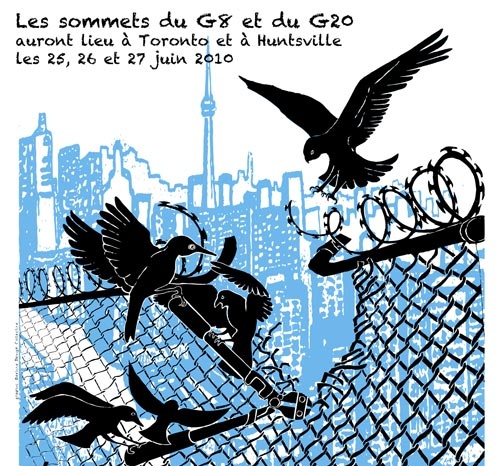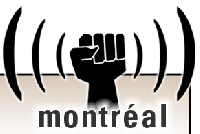 |
 |
 |
 |
 |
 |
|
 |
 |
 |
 |
 |
 |
 |
Régions du Québec |  |
 |
 |
|
 |
 |
|
 |
 |
|
 |
 |
 |
 |
 |
 |
Rubriques (sujets) |  |
 |
 |
|
 |
 |
|
 |
|
 |
 |
 |
The Inuit Project in Villeray: A lost opportunity
Two months after the demise of the Inuit patient housing project in Villeray, many local citizens are still asking themselves questions. Why did none of our elected politicians support the citizens who were in favor of the project? How could the City of Montreal let the borough impose a moratorium on the project? Why was the Montreal Health and Social Services Agency incapable of carrying out the impact studies in a timely manner ? And what will be the long-term impacts of this major setback in communities living together?
Many citizens’ spontaneous reaction to the announcement of the project was very positive and based on inclusive values: an expression of friendship and interest towards a little–known and long-neglected culture and community, respect for a nation with whom we share the space that is Quebec, and a way to show solidarity with people from a small community « de chez nous » who are working hard to address their serious health problems. Despite administrative challenges, politicians had the duty to get their act together to make sure this project proceeded and succeeded. In addition, there were clear advantages for Villeray :
- The arrival of people from the Inuit community would have been an interesting and dynamic contribution to a neighbourhood with an already strong and vibrant immigrant presence ;
- The opportunity to develop closer person-to person contacts between francophones and Inuit who, since the James Bay Agreement in 1975, have had closer relations with the Quebec government and who use French more and more as a second language ;
- A revitalization, both physically and socially, of our neighbourhood with the renovation of a building abandoned for over 10 years ;
- An increase in commercial activity in the area.
STRATEGIES OF EXCLUSION: WHAT HAPPENED ?
Over the past several years, the Nunavik Regional Board of Health and Social Services has been working to bring their scattered patient residents under one roof. The seven present facilities are for patients who come to Montreal for specialized treatments and need a place to stay during their course of treatment. Some patients experienced some unfortunate incidents in the neighbourhoods of the existing facilities. The people from Nunavik, known as Nunavimmiut, also wish to be together in one building, to feel more “ at home ”. The Nunavik Health Authority, with 60 employees, located 2000 kilometers north of Montreal, enlisted the help of the Ministry who handed the file over to the well-resourced Montreal Health and Social Services Agency. It was agreed that the best choice was the former Chinese hospital, property of the Ministry and located in Villeray at 7500 St-Denis. It‘s been vacant for 10 years, and the zoning was appropriate.
But everything falls apart following a meeting in May between the Villeray-St-Michel-Parc-Extension borough and local MNA Gerry Sklavounos, who interestingly, is also the Parliamentary Assistant to the Minister of Health and Social Services.
Borough Mayor Anie Samson will fan the flames: « When you bring 125 people to Montreal, who are not familiar with the City, it’s going to be party time! It’s dreaming in Technicolor to believe that there won’t be problems with their behaviour in the neighbourhood ». This irresponsible and ill-founded declaration, that associates Inuk with uncivilized behaviour, will send a strong hostile message throughout all Northern communities. And Samson’s subsequent “clarifications” will not change anything, since in the meantime, the Borough council will have placed a moratorium on the project, an exceptional measure never before used for a residential project. Could there have been a link between the refusal of the Inuk initiative and the development of a luxury condo project located at 7400 St-Laurent, a project that sailed through the Borough Council?
In May 2010, residents receive an anonymous racist pamphlet in their mailbox : “A project proposed by the Montreal Health Agency is threatening to radically diminish the quality of life in our neighbourhood, will put your safety and security into question and might cost you thousands of dollars in terms of the resale value of your house.” The leaflet refers people to the Borough for more information - the politicians, of course, will distance themselves from this tract. But the damage is done. Inuk are now the victims of racial profiling. The association is clear. The project equals homelessness, prostitution, alcoholism and criminality.
The two Health Agencies (finally!) organize a public information meeting on June 16th. New opponents, now with more finesse, align themselves with borough councillor’s Elsie Lefebvre’s position. They question the choice of the site… “ too far far from the anglophone hospitals where Inuk receive treatment ”, and they ask for numerous impact studies out of proportions to the project. These demands will later be forwarded to the Montreal health authorities “on behalf of the citizens ”. In this climate of political bickering between the local Parti Québécois riding association and Liberal MNA Gerry Sklavounos, it becomes clear that the projet is in serious jeopardy even before a final proposition is put on the table.. That night many “Villeraymmiut” are ashamed of their neighbourhood.
On July 6th, fifteen citizens demand that the Borough lift the moratorium. Mayor Samson responds “Ask the Montreal Agency what they are doing with the impact studies!” The Agency answers : “It’s not our responsibility.” On September 9th, despite a petition of 654 names in favor of the project, the Nunavik health authorities give up on the project in Villeray, stating that “the hurt inflicted is too deep for us to pursue the project”.
A FEW QUESTIONS
This tragic failure is still of great concern to many citizens in the area and remains an important issue for community organizations :
Mayor Tremblay, What will be the impact on intercultural relations in Villeray and in Montreal ? Where were you in all this ? It wasn’t, and never was, just a local zoning question.
And what will happen when the Nunavik Health Agency tries to develop its patient residence in another neighbourhood, Minister Bolduc?
Gerald McKenzie, a long-time observer and experienced in the relationships between Inuk and the larger society, sums it up well : “The causes for the failure go beyond the Villeray-Nunavik situation. This episode evoked opinions on community radio in the North and among Inuk political leaders and they dealt with the whole Québec-Nunavik relationship, not only the failed project in Villeray.”
And Prime Minister Charest, What will you do to re-establish better relations between our two nations ?
Geneviève Beaudet, former spokesperson of the Comité citoyen en faveur du Centre d’hébergement pour patients inuit dans Villeray, and 63 Villeraymmiut :
Alain Chénier,
Alain Cuerrier, chercheur au Nunavik, écrivain,
Alain Long,
André Richer, ex-dentiste au Nunavik,
Ariane Gosselin-B.,
Aude Maltais-Landry,
Bernard Massé,
Blaise Rémillard, Québec Solidaire Laurier-Dorion,
Brigitte Beaudet,
Bruno Morin,
Caroline Bergeron, Centre des femmes d'ici et d'ailleurs de Villeray,
Charles Rainville, président, Association des locataires de Villeray,
Christian Pépin,
Claire Harvey,
Daryl Hubert,
David Milot,
David Murray,
Emmanuelle Doré,
Francine D’Ortun, professeur titulaire, Département des relations industrielles, UQO,
François Van Vliet,
Gaël Morin, organisateur communautaire,
Geneviève Handfield,
Geneviève Lussier,
Ginette Renouf,
Ginette Thibault,
Hélène Larose,
Isabelle Leduc,
Jean-Claude Laporte,
Jean-François Demers, ing.,
Joëlle Legault-Monty,
Johanne Laplante,
José Bazin,
Julie Châteauvert, travailleuse culturelle,
Keven Provençal,
Louise Desjardins, écrivaine,
Louise Lacroix,
Lyse Cloutier,
Maria Stuart, militante,
Marie-Ève Michaud,
Marie-Josée Bernard,
Mathieu Petit-Clair,
Kaitlin Vida Kelly,
Mélissa Castro Harvey,
Mélissa Michaud,
Micheline Lemieux,
Myrto Icart,
Nathan Dratler,
Nikolas Barry-Shaw,
Odette Lavigne,
Kate McDonnell,
Patrick Doiron-Cadrin,
Paul Dumais,
Paulina Maya, organisatrice communautaire,
Pierre Blais,
Robert Prévost,
Scott Ian Murray,
Sébastien Brodeur-Girard,
Sonia Haddad.,
Stéphanie McConnell-Enright,
Sylvie Piché,
Valérie Lefebvre-Faucher,
Véronique Martineau,
Vincent Coraini
21 citizens from other neighbourhoods :
Amy Newton McCann, Montréal,
André Trépanier,
Anne Latendresse, professeur agrégé, Département de géographie, UQAM, Ahuntsic,
Annie-Claude Lachance, Ahuntsic,
Christian Maltais, être humain,
Denise Rousselle, Faiz Abhuani, Parc-Extension,
Francine Boucher, ex-résidente de Villeray,
Gérald McKenzie, conseiller en éducation au Nunavik,
Guy Simoneau, cinéaste, Montréal,
Jean Desjardins,
Josée Cardinal, québécoise,
Julie Marcoux, travailleuse sociale, Montréal,
Louise-Caroline Bergeron, mère et doctorante en sciences humaines appliquées, Petite-Patrie,
Madeleine Galarneau,
Martin Jalbert, Montréal,
Patrice P.-Martel, Montréal,
Patrick Henein,
Philippe de Grosbois, Petite-Patrie,
Ruba Ghazal, Montréal,
Serge Mongeau, écrivain, Parc-Extension.
A. ONLINE RESOURCES
1. Enquête de santé auprès des Inuits du Nunavik 2004
2. James Bay and Northern Quebec Agreement
3. Anie Samson’s interview on May 10
4. Elsie Lefebvre’s interview on June 16
5. Project présentation from ASSSM and NRBHSS on June 16
6. Press release from Gerry Sklavounos in Progrès de Villeray on September 9
7. Press release from Nunavik on September 9
8. Hostile partisan quarrels between PQ and Gerry Sklavounos in local paper
B. OTHER AVAILABLE DOCUMENTS DISPONIBLES
1. Racist pamphlet distributed in May
2. Letter from VSMPE to ASSSM on June 21st
3. Petition of 654 names in favor of the project deposited on September 7
4. Letter from ASSSM to the citizen’s Committe by e-mail on September 8
[ EDIT (Mic à titre de validation au CMAQ)
* Added spaces between the paragraphs
* Various esthetic improvements
* Selected the topics: same as the French version
* Placed the names as a list.]
 |
 |
 |
 |
Dossier G20 |  |
 |
 |
|
 |
 |
|
 |
Nous vous offrons plusieurs reportages indépendants et témoignages...

Liste des activités lors de ce « contre-sommet » à Toronto Vous pouvez aussi visiter ces médias alternatifs anglophones... Centre des médias Alternatifs Toronto 2010.mediacoop.net Media Co-op Toronto http://toronto.mediacoop.ca Toronto Community Mobilization www.attacktheroots.net (en Anglais) |
 |
 |
 |
 |
 |
 |
 |
CMAQ: Vie associative |  |
 |
 |
|
 |
 |
|
 |
 Collectif à Québec: n'existe plus. Impliquez-vous ! |
 |
 |
 |
 |
 |
 |
 |
 |
|
 |
 |
 |
Ceci est un média alternatif de publication ouverte. Le collectif CMAQ, qui gère la validation des contributions sur le Indymedia-Québec, n'endosse aucunement les propos et ne juge pas de la véracité des informations. Ce sont les commentaires des Internautes, comme vous, qui servent à évaluer la qualité de l'information. Nous avons néanmoins une
Politique éditoriale
, qui essentiellement demande que les contributions portent sur une question d'émancipation et ne proviennent pas de médias commerciaux.
This is an alternative media using open publishing. The CMAQ collective, who validates the posts submitted on the Indymedia-Quebec, does not endorse in any way the opinions and statements and does not judge if the information is correct or true. The quality of the information is evaluated by the comments from Internet surfers, like yourself. We nonetheless have an
Editorial Policy
, which essentially requires that posts be related to questions of emancipation and does not come from a commercial media.


